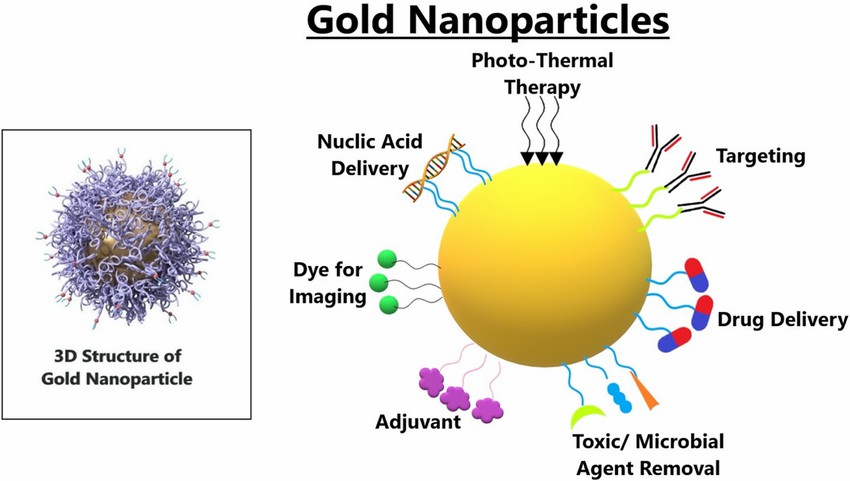Negative control gold nanoparticles
BRP-02401
Negative control gold nanoparticles refer to the gold nanoparticles used in experiments to assess their effects on cells or biological systems, serving as a reference material that does not induce biological responses or toxicity. The primary purpose of a negative control is to provide a baseline, allowing researchers to determine whether the biological effects observed with other experimental materials or chemicals are due to their inherent properties rather than experimental conditions or other factors.
 The structure of gold nanoparticles (Dristant, Utkarsh, et al, 2023)
The structure of gold nanoparticles (Dristant, Utkarsh, et al, 2023)
Citrate-stabilized AuNPs are considered effective negative controls because studies have shown that they do not significantly affect cellular metabolic activity or neurite outgrowth at specific concentrations. This means that in toxicology research, AuNPs can serve as a reliable control material, helping researchers better understand the potential impacts of other compounds or nanomaterials on cells. By comparing the effects of AuNPs with known chemicals (such as lithium), the negative control characteristics of AuNPs can validate the reliability and consistency of the experimental results.
The stability and performance of Negative Control Gold Nanoparticles are influenced by various factors, including surface modifications (e.g., ligand type and charge), environmental conditions (e.g., pH, ionic strength, and temperature), solvent properties (e.g., polarity and organic solvents), storage conditions (e.g., light exposure and oxidation), preparation methods (e.g., synthesis process and purification steps), particle characteristics (e.g., size and shape), biomolecular interactions (e.g., protein adsorption), and mechanical stress (e.g., stirring or sonication). To maintain their stability, these conditions must be optimized and properly characterized.
Diameter (1.8-1500 nm), OD50, Non-reactive, Buffer (stable from pH 4-9; 18MEG DI water, PBS, MES, Sodium Borate, TRIS), Volume (1mL, 5mL, 10mL and more), in vivo grade.
Refrigerator.
Jeerage, Kavita M., et al. Toxicology in Vitro 29.1 (2015): 187-194.
Gold nanoparticles (AuNPs) are promising candidates for medical diagnostics and therapeutics, due to their chemical stability, optical properties, and ease of functionalization. Citrate-stabilized reference materials also have potential as negative controls in toxicology studies of other nanoparticles. Here we examine the impact of 30 nm particles on the in vitro development of rat-cortex neural progenitor cells (NPCs), which mimic aspects of the developing neurological environment. AuNPs dispersed in a low-serum culture medium initially agglomerated, but then remained stable during a three day incubation period, and agglomerated only slightly during a ten day incubation period, as determined by dynamic light scattering. Transmission electron microscopy indicated the presence of individual nanoparticles at all timepoints examined. Fixed cells were cross-sectioned by ion milling and imaged by scanning electron microscopy and helium-ion microscopy to evaluate particle incorporation. Individual nanoparticles could be resolved inside cross-sectioned cells. AuNPs were incubated with developing NPCs for ten days at concentrations of 0.5 μg/mL Au, 0.1 μg/mL Au, or 0.05 μg/mL Au. Adenosine triphosphate levels, as determined by bioluminescence measurements sensitive to low cell numbers, were not affected by AuNPs and the particles did not interfere with the assay. Multiple endpoints of neurite outgrowth were not altered by AuNPs, in particular, total neurite outgrowth per cell, a sensitive measure of neuronal development. Slide-level comparisons demonstrated the consistent response of NPCs to gold nanoparticles and a positive control chemical, neuroactive lithium. These results indicate that 30 nm citrate-stabilized AuNPs could serve as negative-control reference materials for in vitro measurements of neurite outgrowth.
BOC Sciences is a leading provider of DNA and RNA products and services that meet the needs of researchers and pharmaceutical companies worldwide. Its broad product portfolio includes various types of oligonucleotides, DNA/RNA synthesis feedstocks, RNA interference tools, and advanced drug delivery systems, among others. Designed to promote cutting-edge research and innovative therapeutic solutions, at BOC Sciences you are sure to find the right product for you.